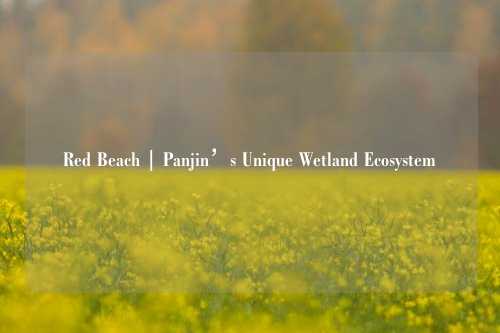Red Beach | Panjin’s Unique Wetland Ecosystem
A Stunning Natural Wonder in China
Red Beach, located in Panjin, China, stands as one of the most visually striking landscapes in the world. Unlike conventional sandy coastlines, this area is covered by a type of seepweed known as Suaeda salsa, which undergoes a dramatic transformation in color throughout the year. The plant starts as a fresh green in spring, gradually deepening into a brilliant crimson by autumn. This natural spectacle, set against the backdrop of the Liaohe River Delta, creates an awe-inspiring view that draws thousands of visitors each year.
The Science Behind the Changing Colors
The mesmerizing red hue of Red Beach is a result of the seepweed’s interaction with the soil’s high salt content. This plant thrives in saline-alkali wetlands, absorbing minerals that contribute to its seasonal color shifts. While it remains green during the warmer months, the arrival of autumn triggers biochemical changes that turn the vegetation into a striking shade of red. This transformation peaks between September and October, making these months the ideal time for visitors to witness the area at its most stunning phase.

A Crucial Habitat for Wildlife
Beyond its scenic appeal, Red Beach serves as a haven for a diverse range of wildlife. The wetlands support over 260 species of birds, including the endangered red-crowned crane and black-faced spoonbill. These migratory species rely on the region as a stopover along the East Asia-Australasia Flyway. In addition to birds, the area is home to various fish and invertebrates, contributing to a complex and balanced ecosystem. Conservation efforts are in place to protect these habitats from human interference, ensuring the wetlands continue to provide sanctuary for these creatures.
Exploring the Wooden Walkways
To preserve the fragile landscape while allowing visitors to immerse themselves in its beauty, a series of wooden walkways have been constructed across Red Beach. These elevated paths extend over the crimson fields, offering panoramic views of the wetlands and their wildlife. Walking along these trails, visitors can appreciate the serene atmosphere while capturing breathtaking photographs of the sweeping red expanse. The boardwalks provide an opportunity to experience the area without causing harm to the delicate plant life below.
The Role of Red Beach in Local Life
Red Beach is not only an ecological treasure but also an integral part of local life. Nearby fishing villages have thrived in harmony with the wetlands for generations. Fishermen continue to use traditional methods to harvest shrimp and fish from the nutrient-rich waters of the Liaohe River. The coexistence of nature and human activity highlights the significance of wetland conservation, ensuring that both the ecosystem and the local way of life can persist for years to come.
Seasonal Changes and Best Visiting Periods
While Red Beach is most famous for its autumnal red hues, its beauty is not confined to a single season. In spring and summer, the wetlands are covered in lush green vegetation, offering a completely different perspective. Winter brings a sense of quiet solitude, with frost-covered marshes creating a stark but equally mesmerizing contrast to the fiery reds of fall. However, for those hoping to witness the area at its most impressive, visiting in late September to early October is highly recommended.
Conservation Initiatives and Sustainable Tourism
Due to its ecological significance, Red Beach is protected under strict conservation policies. Tourism is carefully regulated to minimize human impact, with designated viewing areas and limited access to certain parts of the wetland. Efforts include maintaining water quality, protecting breeding grounds for birds, and educating visitors about the importance of preserving this fragile habitat. These measures help to balance tourism with the need for ecological protection, ensuring the landscape remains unspoiled for future generations.
The Cultural Heritage of Panjin’s Wetlands
Panjin’s wetland region is deeply connected to the heritage and traditions of its people. The fishing villages surrounding Red Beach maintain customs passed down for centuries, from unique boat designs to traditional methods of preserving seafood. Local cuisine, heavily influenced by the abundance of fresh fish and shrimp, offers visitors a taste of the region’s natural bounty. Experiencing the local lifestyle alongside the breathtaking scenery provides a deeper appreciation of the area’s significance beyond its aesthetic appeal.
A Must-See Destination for Nature Enthusiasts
Red Beach stands as a breathtaking example of nature’s artistry, blending striking landscapes with rich biodiversity. Whether visitors are drawn to its vibrant colors, its role as a vital habitat for wildlife, or the cultural traditions that surround it, the wetland offers an experience unlike any other. Walking through the wooden pathways, watching rare birds take flight, and witnessing the seasonal transformation of the seepweed all contribute to an unforgettable journey into one of China’s most mesmerizing natural settings.
















